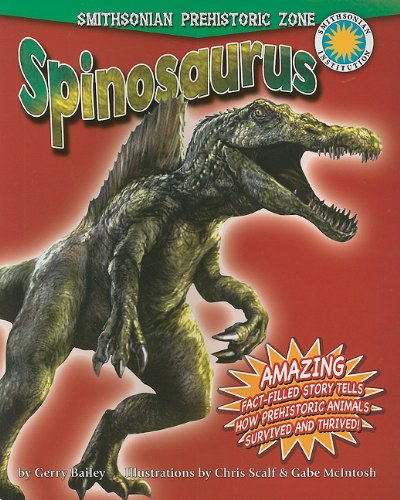-
Sabre-Tooth Tiger
Gerry Bailey, Trevor Reaveley
Paperback (Crabtree Pub Co, Jan. 31, 2011)"Amazing fact-filled story tells how prehistoric animals survived and thrived!"--Cover. Q
Q
-
Spinosaurus
Gerry Bailey, Chris Scalf, Gabe McIntosh
Paperback (Crabtree Pub Co, Jan. 31, 2011)"Amazing fact-filled story tells how prehistoric animals survived and thrived!"--Cover. R
R
-
Tylosaurus
Gerry Bailey, Karen Carr
Paperback (Crabtree Pub Co, Jan. 31, 2011)This book tells the story of Tylosaurus, which swam in the prehistoric seas between 87 and 82 million years ago. It was a fierce marine reptile that used its sharp teeth and huge jaws to feed on sharks and other marine reptiles, such as plesiosaurs, as well as fish. A Tylosaurus could grow as long as 50 feet and was a superb swimmer. R
R
-
Pteranodon
Gerry Bailey, Karen Carr
Paperback (Crabtree Pub Co, Jan. 31, 2011)This book tells the story of Pteranodon. During the late Cretaceous period, between 89 and 80 million years ago, one of the largest flying reptiles to exist flew in the skies. Its large wingspan and short tail made it very agile so it could turn or dive quickly. Its head could measure nearly six feet (two meters) long and on the back of its head grew a magnificent crest. R
R
-
Parasaurolophus
Gerry Bailey, Gabe McIntosh
Paperback (Crabtree Pub Co, Jan. 31, 2011)Realistic illustrations highlight this story about a day in the life of the Parasaurolophus. Created in collaboration with the Smithsonian Institution, information sections give all the vital statistics about Parasaurolophus. T
T
-
Ankylosaurus
Gerry Bailey, Adrian Chesterman
Paperback (Crabtree Pub Co, Jan. 31, 2011)This book tells the story of Ankylosaurus. This armored beast looked like a walking tank. It lived during the Cretaceous period between 100 and 65 million years ago and fed on plant material. At the end of its tail grew a bony club that it used to protect itself. R
R
-
Ankylosaurus
Gerry Bailey, Adrian Chesterman
Library Binding (Crabtree Pub Co, Jan. 31, 2011)This book tells the story of Ankylosaurus. This armored beast looked like a walking tank. It lived during the Cretaceous period between 100 and 65 million years ago and fed on plant material. At the end of its tail grew a bony club that it used to protect itself. R
R
-
Spinosaurus
Gerry Bailey, Chris Scalf, Gabe McIntosh
Library Binding (Crabtree Pub Co, Jan. 31, 2011)"Amazing fact-filled story tells how prehistoric animals survived and thrived!"--Cover. R
R
-
Tyrannosaurus Rex
Gerry Bailey, Karen Carr
Paperback (Crabtree Pub Co, Jan. 31, 2011)Realistic illustrations highlight this story about a day in the life of the mighty Tyrannosaurus rex. Created in collaboration with the Smithsonian Institution, information sections give all the vital statistics about the Tyrannosaurus rex. N
N
-
Velociraptor
Gerry Bailey, Karen Carr
Paperback (Crabtree Pub Co, Jan. 31, 2011)Realistic illustrations highlight this story about a day in the life of Velociraptor, a lightweight dinosaur who used its speed to catch prey. Created in collaboration with the Smithsonian Institution, information sections give all the vital statistics about Velociraptor. T
T
-
Woolly Mammoth
Gerry Bailey, Karen Carr
Paperback (Crabtree Pub Co, Jan. 31, 2011)Realistic illustrations highlight this story about a day in the life of the woolly mammoth. Created in collaboration with the Smithsonian Institution, information sections give all the vital statistics about the woolly mammoth. P
P
-
Triceratops
Gerry Bailey, Karen Carr
Paperback (Crabtree Pub Co, Jan. 31, 2011)Realistic illustrations highlight this story about a day in the life of Triceratops, a dinosaur that was heavier than a present day elephant. Created in collaboration with the Smithsonian Institution, information sections give all the vital statistics about Triceratops. R
R